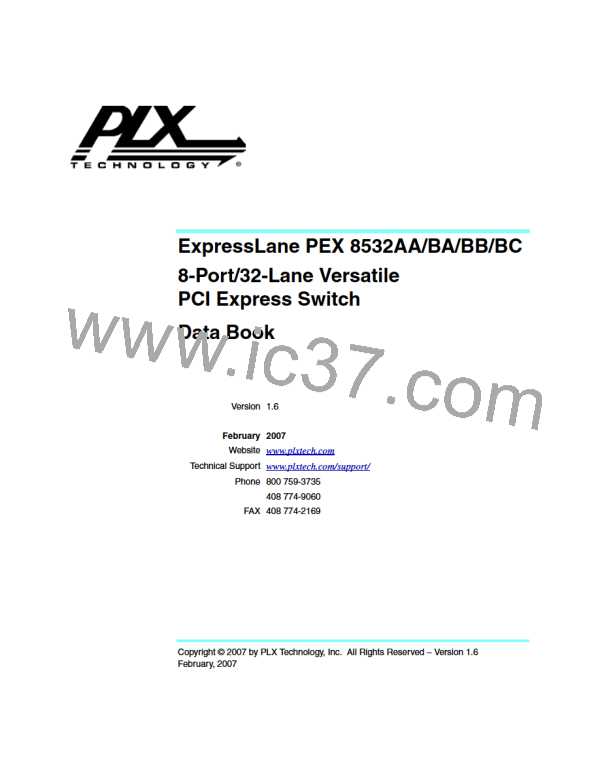Performance Metrics
PLX Technology, Inc.
Ingress Credit Threshold Programming
There are methods for changing the ingress credit threshold – by way of a serial EEPROM or direct CSR
programming. The first approach is straightforward – program the required values and the link produces
the programmed values. However, the latter approach requires further explanation.
In the direct CSR programming method, if a credit threshold requires an increase, perform a CSR Write.
This immediately results in a new UpdateFC to be transmitted, carrying the newly increased credits. In
contrast, if a credit threshold requires a decrease, the PCI Express Base r1.0a does not provide a
pre-defined method for reclaiming unused credit previously advertised to the external device. The
danger of programming a smaller credit threshold than the initial value is that ingress packet storage can
overflow if the external device is not aware of the credit threshold, and continues sending packets
according to the initial credit threshold. Use the following approach to avoid packet RAM overflow:
• Upstream port
– Use CSR access to program the VC&Ts whose credit requires a decrease.
– Transmit “side-impact free” traffic from host to those VC&Ts, to deplete all credits to be
reclaimed. Before the surplus credits are completely reclaimed, the PEX 8532 transmits
UpdateFC for that VC&T. After the amount of incoming traffic attains the difference
between the old and new credit thresholds, the PEX 8532 starts transmitting fresh UpdateFC
DLLPs for incoming TLPs.
• Downstream ports
– Program all ingress credit threshold CSRs in all VC&Ts to the required values.
– Execute a Secondary Bus Reset in the Bridge Control register (offset 3Ch[22]=1)
– Release the reset. The newly programmed values take effect afterward.
Ingress credit threshold registers are not sticky after a primary reset; therefore, this sequence requires
repeating after any primary reset.
Tip: If a serial EEPROM is available and you want to experiment with credit values, initially program
all thresholds to 1. There is no impact in increasing the credit (up to the maximum of PEX 8532
resources). This allows for the most flexibility in your experiments.
8.4.2.2
Egress Side
Provide Sufficient Egress Credit
The simplest way to improve an egress port’s throughput is to provide the PEX 8532 with sufficient
egress credit. In general, the number of egress credit required by the PEX 8532 follows the same
equation as the ingress credit calculation:
Egress_Credit_Required = (Round_trip_time_in_clocks x link_width) /
packet_size_in_bytes
For the PEX 8532 to achieve pipelined performance, the external device is suggested to advertise at least
two MPS worth of payload credits. For 128B MPS, the payload credit is greater than or equal to 16
(16 credits = 296B = 2 MPS). For 256B MPS, the payload credit must be greater than or equal to 32
(2 MPS). Although a packet’s payload is smaller than MPS, without a 2 MPS credit, the PEX 8532
schedules one packet out, waits for the updateFC to return, then schedules the next packet out.
110
ExpressLane PEX 8532AA/BA/BB/BC 8-Port/32-Lane Versatile PCI Express Switch Data Book
Copyright © 2007 by PLX Technology, Inc. All Rights Reserved – Version 1.6

 PLX [ PLX TECHNOLOGY ]
PLX [ PLX TECHNOLOGY ]